About ClickUp
ClickUp is a highly-rated all-in-one project management solution for teams of all sizes. ClickUp allows marketing and SEO teams to collaborate in multiple views, store company knowledge, and increase productivity. Over 800,000 teams are currently using its robust platform.
Business Challenge
Chances are, you’ve heard of ClickUp.
We’re the ones with those controversial Jira smackdown videos, funny Youtube ads, and Lord of the Rings-like airport billboards.
But not too long ago, when you searched on Google for phrases such as “best project management software” or “best Gantt chart software” and many other searches related to our core offerings, ClickUp barely made an appearance.
This is because we were new on the scene and most of the ranking articles were published several years prior, often written and ranked before ClickUp was even founded.
I’m quite passionate about getting ClickUp placed on these articles, because as a platform, it absolutely blows away the other options. I’ve used Asana, Monday, and Notion extensively, and know it lives up to our claims—ClickUp really does replace them all.
Enter Surround Sound SEO
As a marketer, this Surround Sound SEO strategy—getting other pages already ranking for our keywords to recommend ClickUp—made absolute sense. Not only should our ClickUp content rank across these competitive terms, but we needed to get ClickUp mentioned in every other ranking article.
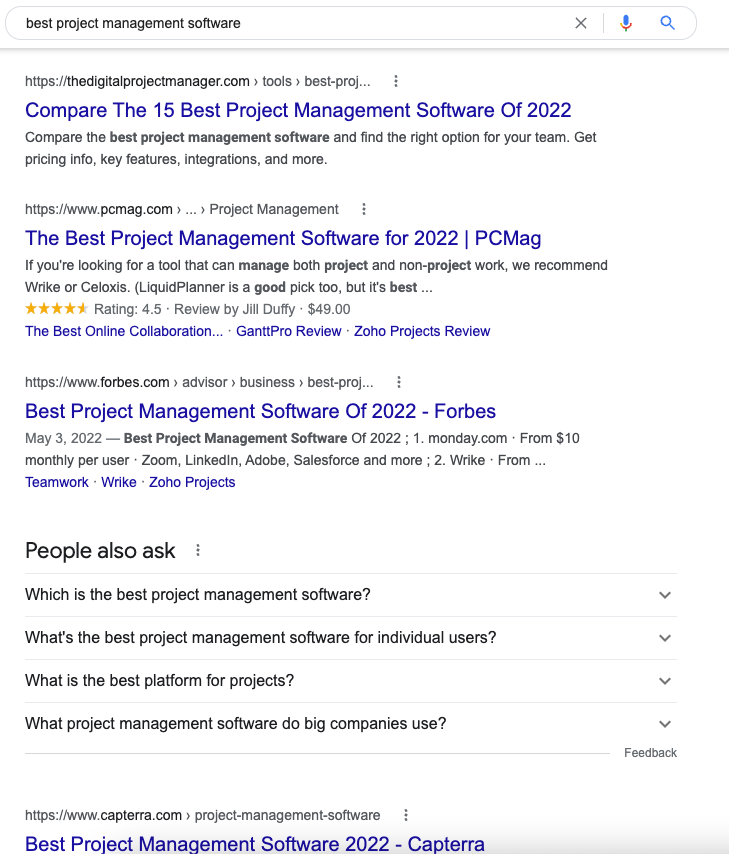
But as an SEO specialist, link building is only a fraction of my daily role and the Surround Sound SEO strategy just one of many.
In essence, our small but mighty team of three people faced several challenges:
- Competing link building strategies
- Lack of impactful business metrics to convince other teams and stakeholders
- Time consuming processes to identify the most promising link targets
Competing Link Building Strategies and Prioritization
A common goal among link building teams is to have a “link quota.” Based on my experience and reports from outreach managers I’ve spoken to, this ranges from 20-50 links per month for each SEO hire. At ClickUp, before we prioritized Surround Sound, I was responsible for generating 40 links per month, but only about half of my time was dedicated to that effort.
To effectively meet our goals, we had to prioritize the most efficient links and spend our time on the ones that worked best and that we could achieve quickly.
“Normal” editorial link building like Skyscraper or broken link outreach doesn’t take much time. After establishing an agreement with webmasters, they’d usually agree to update their article. The process could often be completed in just 24 hours. But Surround Sound link placements require a bit more time than typical outreach:
- We need to write a small blurb about ClickUp to help them understand how it fit into the context of their article—not necessary with editorial links.
- Because we are targeting pages that rank for high-intent keywords, we often need to get more buy in than usual. For example, some webmasters need approval from their manager or content team to make such a visible change (compared to simply adding a link).
- The webmaster may also need to tweak the content we send them to match their brand voice.
So I had to ask myself—if I could earn links faster through editorial link building, why would I spend more time and energy to acquire a Surround Sound link? More on that later.
This led to my second problem.
Lack of Metrics That Tie into Business Impact
Given the extra time required—are Surround Sound links even worth it?
Intuitively, I knew that Surround Sound links are much better links than standard editorial placements. After all, from a brand perspective, wouldn’t we rather have an entire section about ClickUp in an objective, 3rd-party article instead of a link on anchor text?
Still, in order to successfully scale the Surround Sound strategy, we needed our content team fully on board because they’d be the ones responsible for writing all the ClickUp blurbs to match the intended article.
We also needed to convince marketing leadership of the value behind the Surround Sound strategy to get the necessary resources. And it can be difficult to tie link building efforts directly to business metrics like revenue, conversions, or even traffic.
Stakeholders understand referral traffic, but outside of that, there’s no metric. On top of this, even high-traffic partner blogs generate very few referral visits as measured by the Google Analytics referral traffic.
These referral clicks don’t take into consideration other benefits such as brand visibility, increased branded search and direct traffic, and impressions generated.
Time Consuming Process to Identify Target Pages
Anyone in link building will tell you—finding opportunistic placements on partner domains is time consuming. Sometimes you need to use a scraping tool like Screaming Frog, sometimes you use Google search operators to find particular keywords in blog content. And if you’re really going for quality, that process also involves screening these opportunities through a tool like the Semrush On-Page Checker.
You might even need to repeat this process multiple times to search additional partner domains. All of this leads to a long research process and delayed negotiation.
Additionally, if you’re running a cold outreach campaign, building a list of pages and domains can take a lot of time. For example, if we wanted to get ClickUp mentioned in all articles ranking for “project management software,” we would have to vet each individual result from the SERP. Then, we’d multiply that across different variations of “project management software” to build a final prospecting list.
This takes a lot of time and is a siloed effort. For example, how do we know that “project management software” has the most potential visibility for us? Zooming out, is it better to focus on a “project management software” campaign or a “gantt chart software” campaign? You get the idea—there’s always another angle to consider.
So, how did we fix this issue?
Solution
With the aid of Semrush’s new share of search tool, Surround Sound, we’ve able to formalize our Surround Sound processes and address many of these pain points.
Here are some solutions that are working for us:
Track Our Visibility for High-Intent Keywords
First, we needed to see how we fared across all of our high-intent keywords.
We set up a keyword list for link tracking that closely aligned with our content strategy. That way, we could align Surround Sound link building with our content SEO goals. To do this we used Google Search Console to export a list of all “app,” “software,” and “tool” based queries that we already ranked for.
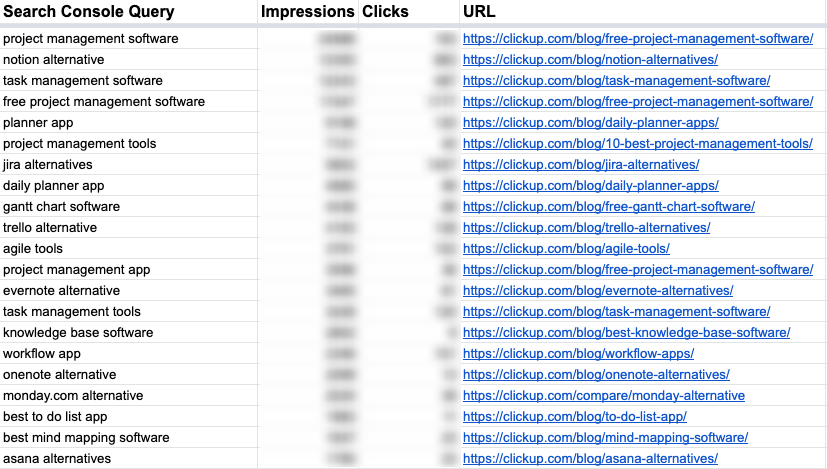
After cleaning the data—eliminating close variants, low impression, and irrelevant keywords—we imported the final list of 900+ keywords into the Surround Sound tool.
Now we can see what keywords we already have great visibility for, as well as our greatest potential keywords. Surround Sound’s nifty calculation for potential traffic visibility factors in your current visibility and Semrush’s search volume data.
In the screenshot below, you’ll see that we had no visibility but a ton of great potential for five high search volume terms so we knew where to focus for immediate impact.
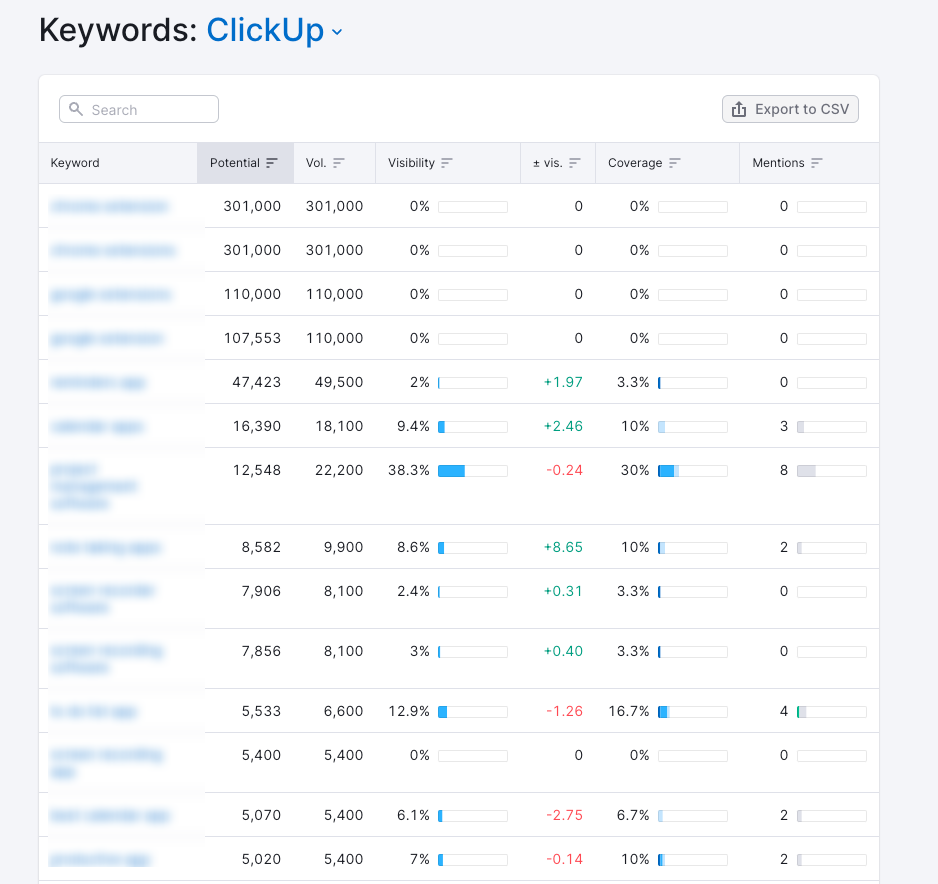
Compile High Traffic Targets and Sized Opportunities
Link building teams usually start cold outreach campaigns by compiling a list of target domains and pages—and at first, we were no different.
Imagine building a list of all pages that rank for “project management software.” Then adding more pages that rank for “project management tools.” Then adding ones that rank for “free project management software.”
…And that’s just 3 keywords. What if you had to do that for 900 keywords?
Surround Sound’s Pages report completely removes the need for this manual step. It aggregates all the opportunities by traffic for each domain, thus saving us hours of manual effort looking for the best opportunities. Note: you can also choose to view a list of pages if you prefer.
Grouping opportunities by domains enables you to take advantage of account-based link building. Rather than reaching out individually to get placed in articles, you establish long-term partnerships with these domains.
Luckily, we’ve already built our partnership CRM database in ClickUp that helps us identify an existing relationship with sites that appear on this list. We work on those first, eliminating the need for cold outreach.
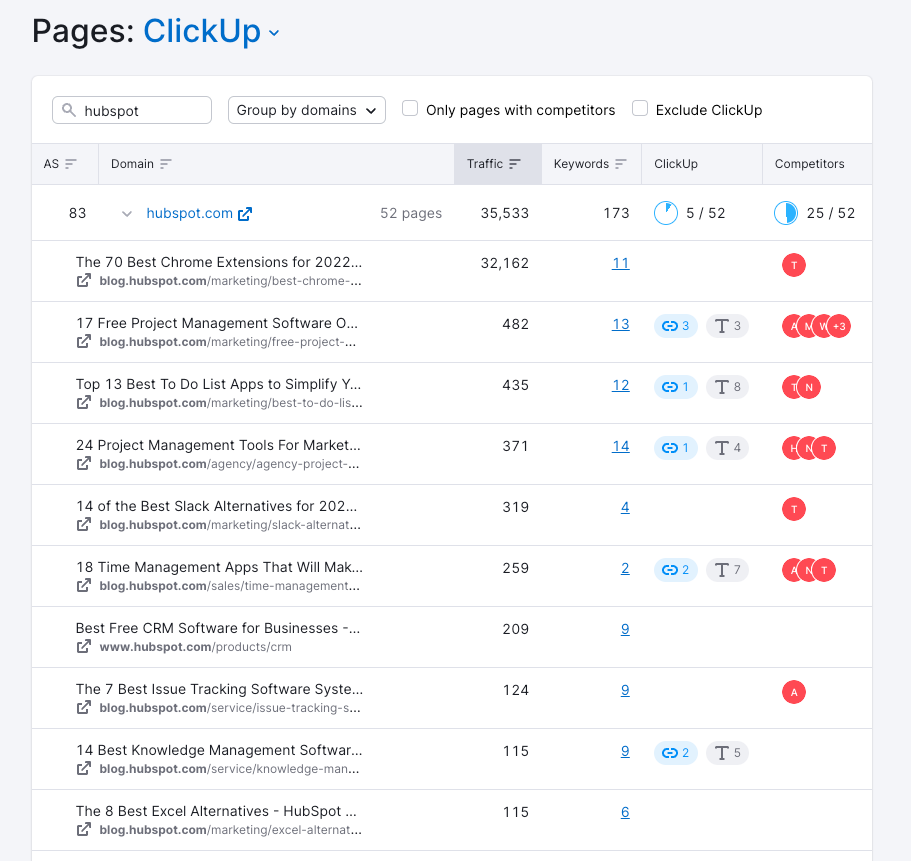
For example, HubSpot is an existing partner of ours and we've gotten placements for ClickUp there this year. Using “Pages” in the above screenshot, we immediately find 52 more opportunities for links from HubSpot.
Now I simply reach out to my contact at HubSpot to find a way to be added to these articles! Voila!
The tool saves us a substantial amount of time by grouping these opportunities and eliminating the need to patch together different scraping tools or manual domain analysis.
Another way to use the Pages dashboard in Surround Sound is for prioritizing cold outreach targets. For example, based on the number of pages that rank for our keywords, and in combination with estimated traffic, the screenshot below illustrates how Surround Sound helps us decide where we should spend the most time building relationships.
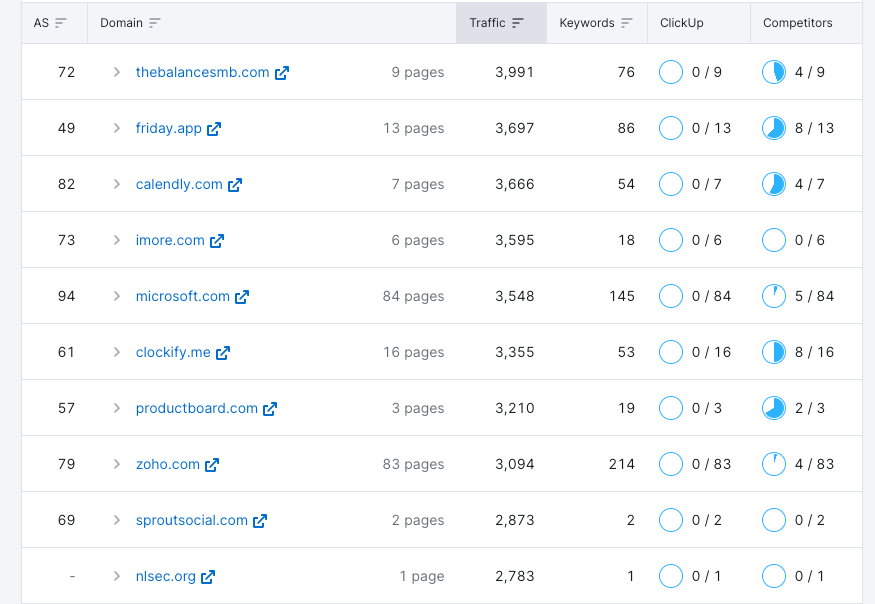
We know that Sprout Social is less of an opportunity with two URLs ranking for two keywords and 2,873 estimated traffic than a site like Friday.app that has 13 URLs ranking for 86 of our target keywords and 3,697 in estimated traffic.
So we’ll likely prioritize building a relationship with Friday.app before Sprout Social.
Set Up a Workflow for Surround Sound Links
With our Surround Sound campaign set up, we created a workflow in ClickUp to scale the campaign.
Because outreach for obtaining Surround Sound mentions requires heavy buy-in from the content team, we had to make it easy to request the needed copy and track task activity. By using ClickUp Forms, the SEO team can request a content blurb and note essential details such as the partner URL, ClickUp landing page links, and value proposition.
ClickUp’s platform turns these form submissions into tasks assigned to our content team which automatically populate into our Kanban view.

This workflow streamlined the content production process, creating standardized steps that are easy to duplicate for every new mention and blurb. It also decreased lead time and produced consistent quality content that matched our partner’s tone of voice and the topic of the page. Where it used to take 2-3 weeks to get copy completed, it now takes a week or less.
Create Reports to Show Progress
Surround Sound’s dashboard makes regular monitoring and weekly updates easy to read and navigate. You’ll see changes in the number of mentions, coverage, average visibility, and estimated traffic.
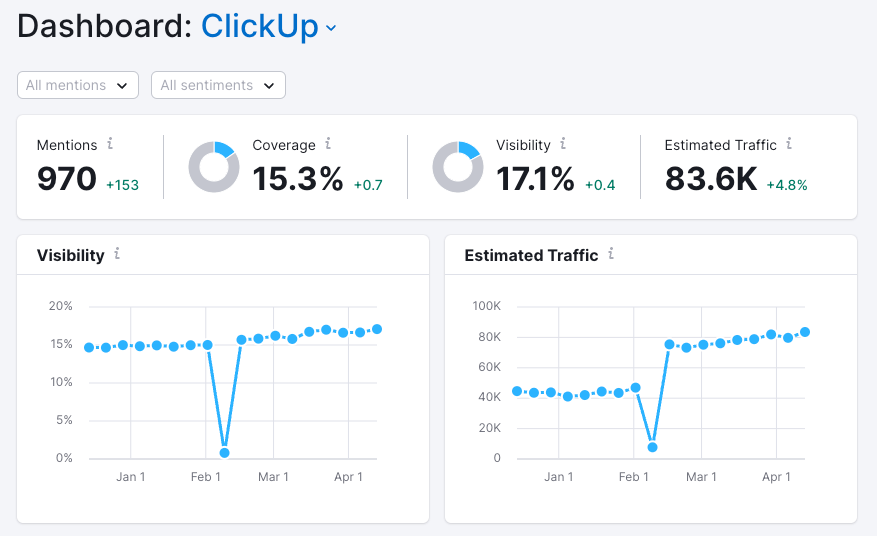
With this dashboard, we get a bird’s eye view of ClickUp’s visibility and see how new placements have affected our trend.
We could also export the data to track changes and do deeper analysis, making it possible to set granular goals and benchmarks. At ClickUp, we created our own Google Data Studio dashboard to display Surround Sound data in different angles and configurations. For example, we can monitor the historical performance of individual keywords, as shown in the example below:
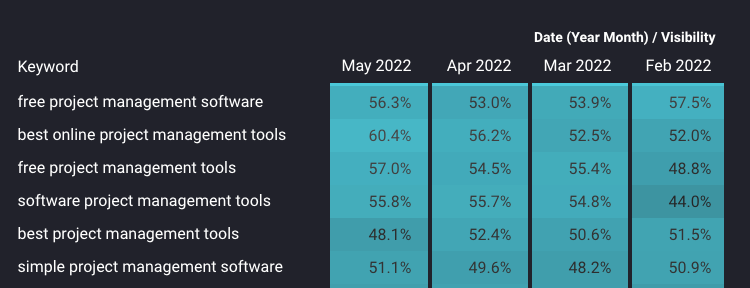
We can also monitor an entire cluster or topic.
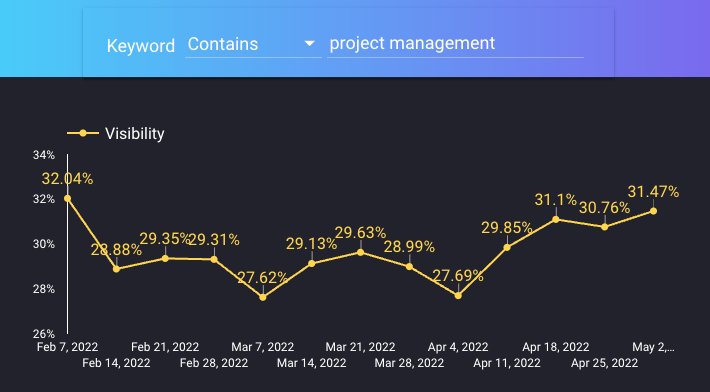
This helps us get a pulse on the “health” of our Surround Sound SEO for different topics we’re targeting.
Results
With Surround Sound, we finally have the data and benchmarks in place to show the value of Surround Sound beyond referral traffic. We can also engage cross-functional teams and save hours of work that would otherwise have been dedicated to manual prospecting and reporting.
Here are some results we got from leveraging this tool:
The Ability to Prove the Impact of Our Work
We used Surround Sound data and a historical SERP analysis to show stakeholders the growth in visibility for a sample set of keywords important to our software and features from a six-month period in 2021. In the example below, we focused on the increase in visibility for six important “alternative” keywords.
For example, ClickUp’s visibility for “Jira alternatives” increased 17% after being featured on partner sites and as our own article began ranking higher.
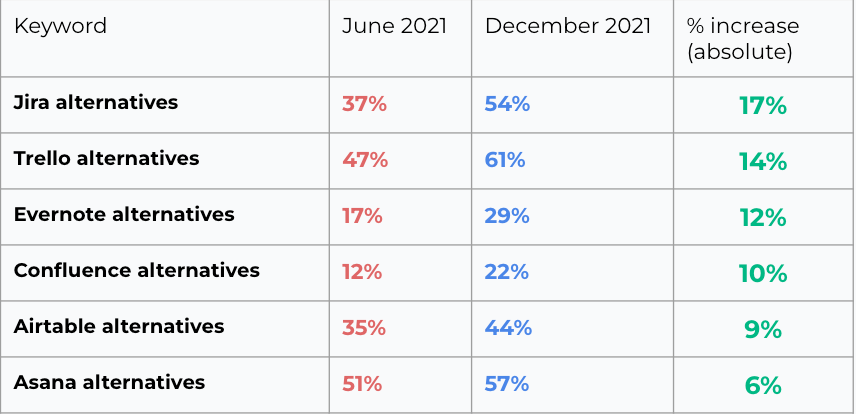
While there is not yet a way to accurately attribute these visibility numbers to traffic and new product sign ups, I’ve come up with some rough formulas that allow me to secure buy-in for more outreach and link building resources.
First, we need to calculate the change in brand impressions due to change in Surround Sound visibility.
Using Google Search Console’s data for Keyword Impressions and Surround Sound visibility data, this is the formula we used:
Δ Brand Impressions = Keyword Impressions x Δ Brand Visibility
Running this calculation on the sample set of six keywords showed that better visibility likely resulted in 2,150 more brand impressions per month for ClickUp.
This is essentially 2,150 new organic views to ClickUp because we have more visibility in the SERPs for those six keywords.
To estimate new product sign ups from this increase in brand impressions, we took an average conversion rate (CVR) of our own articles ranking for the sample set of keywords. For this, we’ll use a rough estimate of 2.8%.
Then we used the formula:
Δ Product Sign Ups = Δ Brand Impressions x Avg CVR
Based on this calculation, we can estimate that better visibility for these six keywords resulted in approximately 60 more product sign ups per month.
Since articles can rank for hundreds if not thousands of keywords, and our Surround Sound campaign focused on many other keyword groups beyond this sample set, our work likely had much more impact than the simple formula indicates.
Smarter Prioritization Across the Team
Our next big win was the ability to prioritize our time across the team, as we can now call out actual numbers and data. Whenever a placement goes live, our reporting shows a large jump in organic search visibility.
With the dashboards we built from Surround Sound, we can present these findings in our biweekly SEO reports and again call attention to our content team members. For example, this screenshot shows a large increase in visibility after a successful placement in March on a partner blog generating traffic.
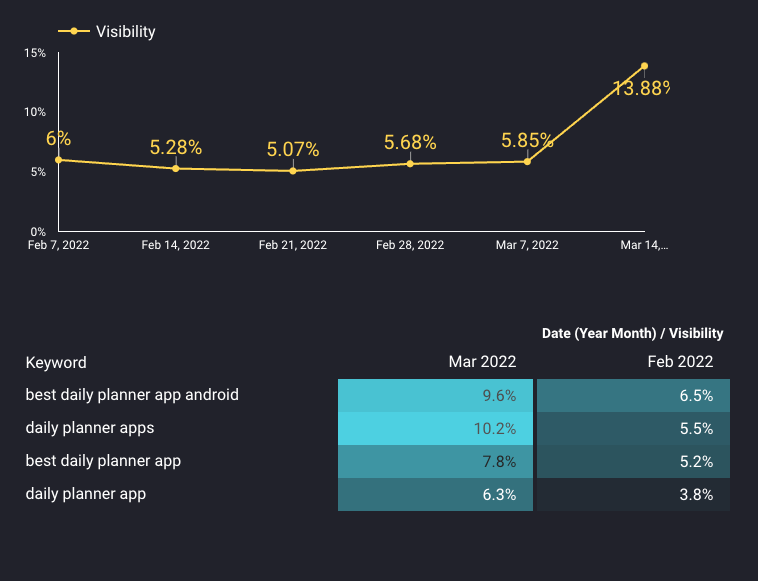
With this simple metric from Surround Sound, writers and non-SEO marketers can get excited about link building and the opportunities it brings.
It also allowed us to celebrate team members who contribute to the success of Surround Sound links. We announce these in company-wide Slack channels.

Hours Saved on Manual Prospecting and De-Duping
For our SEO team, the “Pages” feature was the biggest win, as we no longer had to dig through Google to find opportunities with search operators and compiling from individual URLs.
Now, we can target pages and domains with the highest potential opportunities at once. This saves time in the research and negotiation stage of link building, and eliminates inefficiencies due to one-off exchanges and transactions. Because of the larger scope of work, the tool allows us to deepen our relationships with partners.
Conclusion
Through the Surround Sound strategy, our content and SEO team has gotten ClickUp placed in nearly 100 articles in the past 12 months. And these aren’t just any articles. They’re articles ranking for high-intent keywords that can deliver customers who are ready to buy.
With the support of Semrush’s new tool, we can now easily track the impact of these wins. We can also take a more data-centric approach to our goals, increase prospecting efficiency, and identify new opportunities. Coupled with our new content workflow created in ClickUp and buy in from other teams, we’ve reduced lead times and created a whole new focus to link building.
We’re looking forward to ramping up Surround Sound SEO in the coming months to spread ClickUp’s platform and mission to save everyone one day a week!
